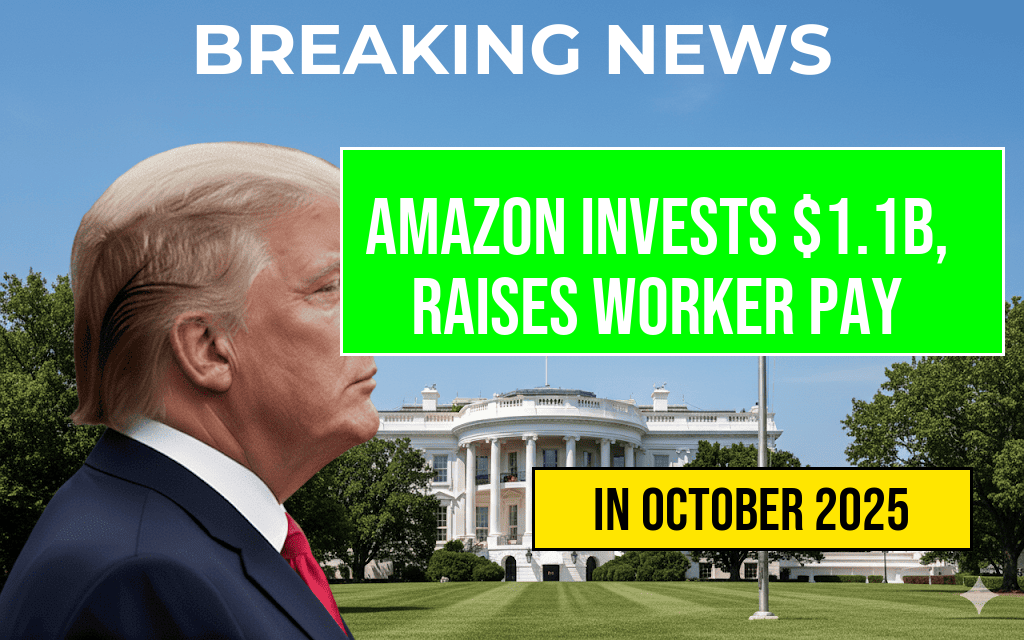Amazon announced a substantial investment of $1.1 billion aimed at enhancing its fulfillment network across the United States, a move that directly impacts thousands of workers. As part of this strategic infusion, the e-commerce giant has committed to raising the average pay of its fulfillment center employees to over $23 per hour. This increase marks a notable shift in Amazon’s labor strategy, reflecting both competitive pressures and its effort to address workforce retention amid a tight labor market. The investment is expected to bolster warehouse infrastructure, upgrade logistics technology, and provide wage enhancements, positioning Amazon to better meet growing consumer demand while offering increased compensation to its frontline workers.
Details of Amazon’s $1.1 Billion Investment
Scope and Allocation
- Upgrade of existing fulfillment centers to improve efficiency and safety standards.
- Expansion of new fulfillment facilities in key markets nationwide.
- Implementation of advanced robotics and automation technology to streamline operations.
- Workforce development initiatives, including training programs and wage increases.
Impact on Fulfillment Workers
| Current Average Pay | Projected Average Pay | Estimated Number of Affected Workers |
|---|---|---|
| $18.50/hr (average prior to increase) | $23.00/hr (current target) | Over 500,000 |
The company’s internal data indicates that the wage bump will benefit a significant portion of its U.S. fulfillment workforce, which has faced longstanding pressure to improve compensation amid rising operational costs and labor shortages. Amazon spokesperson Kara Hurst emphasized that the company’s goal is to provide “competitive wages and a safe working environment,” aligning with broader industry trends to attract and retain skilled warehouse personnel.
Industry Context and Competitive Response
Amazon’s decision to invest heavily in workforce pay mirrors a broader shift within the logistics and e-commerce sectors. As companies grapple with labor shortages and rising wages, many are revising pay structures and benefits. According to data from the Wikipedia entry on labor shortages, the U.S. freight and logistics industry has experienced significant workforce gaps, prompting competitors like FedEx and UPS to increase wages and improve working conditions.
Market Reactions and Employer Strategies
- Enhanced wages serve as a tool to reduce turnover rates in high-demand roles.
- Investments in automation aim to complement human labor, reducing physical strain and increasing productivity.
- Public perception of Amazon’s labor practices may shift positively as wages improve.
Experts suggest that such investments could influence industry standards, prompting other companies to follow suit to remain competitive. According to Forbes, wage increases in fulfillment centers are increasingly viewed as necessary for sustainable operations rather than mere competitive gestures (Forbes coverage).
Broader Implications for Amazon and the Workforce
While the $1.1 billion investment primarily boosts wages and infrastructure, it also reflects Amazon’s strategic shift towards more sustainable employment practices. Historically criticized for demanding high productivity with minimal regard for worker well-being, the company’s recent actions suggest an acknowledgment of the importance of workforce stability. Analysts note that increased pay can lead to improved morale, lower absenteeism, and higher throughput, which benefits both Amazon and its customers.
Worker Perspectives and Industry Challenges
Labor advocates and workers have expressed cautious optimism about the wage increases, but concerns remain regarding working conditions and job security. The retail and logistics sectors continue to face challenges balancing automation with human employment, as well as ensuring equitable treatment for all workers.
Looking Ahead
As Amazon implements its $1.1 billion plan, the company appears poised to set a new benchmark in fulfillment center wages. The move signals an awareness of the evolving landscape, where worker compensation and technological advancement go hand in hand. Industry observers will be watching closely to see if other giants follow suit, potentially reshaping the standards for employment in the e-commerce sector.
For more insights into Amazon’s labor practices and industry trends, visit Amazon on Wikipedia and Forbes.
Frequently Asked Questions
What is the total investment Amazon has made to improve worker pay?
Amazon has invested 1.1 billion dollars to boost the pay of its fulfillment workers.
How has Amazon’s investment impacted the average pay of fulfillment workers?
Following the investment, the average pay for Amazon’s fulfillment workers has increased to over twenty-three dollars per hour.
Which employees are affected by Amazon’s pay increase?
The fulfillment workers at Amazon’s warehouses and fulfillment centers are directly impacted by this pay increase.
When did Amazon announce the pay increase and investment?
Details about the timing can vary, but the investment and pay raise have been publicly announced recently as part of Amazon’s ongoing efforts to improve worker compensation.
What is the significance of this pay increase for Amazon’s workforce?
This pay boost reflects Amazon’s commitment to supporting its fulfillment workers and maintaining competitive wages in the logistics industry.








